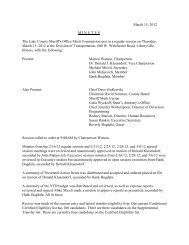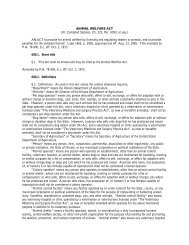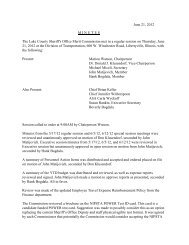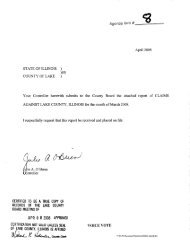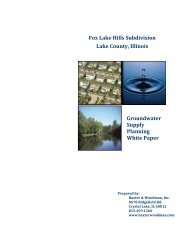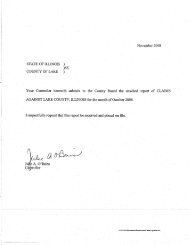Bull Creek - Bull's Brook e-News - Lake County Illinois
Bull Creek - Bull's Brook e-News - Lake County Illinois
Bull Creek - Bull's Brook e-News - Lake County Illinois
Create successful ePaper yourself
Turn your PDF publications into a flip-book with our unique Google optimized e-Paper software.
May 2013<strong>Bull</strong> <strong>Creek</strong> - <strong>Bull</strong>'s <strong>Brook</strong> e-<strong>News</strong>UpcomingWatershedCouncilMeetingPlease join us forthe next <strong>Bull</strong> <strong>Creek</strong>-<strong>Bull</strong>’s <strong>Brook</strong>Watershed Councilmeeting onMay 13, 2013 from9:00-11:00 am, atthe LibertyvilleTownship Office,359 Merrill Court,Libertyville, IL.Look for theagenda in theweeks before themeeting.Mark YourCalendarMonday, August 12,2013 ∙ LibertyvilleTownship, LibertyvilleMonday, November11, 2013 ∙ <strong>Lake</strong><strong>County</strong> Forest PreservesDistrict Office,LibertyvilleProgramThe Role of Phosphorus on the EnvironmentCitizen Scientists’ Survey <strong>Creek</strong>By Steve Cepa; Liberty Prairie Area Homeowners AssociationJuly 20, 2005 started as a hot and humidday with a forecast of thunderstorms.As midafternoon approached, the humiditywas 81% and the temperature 86 o withstorm clouds moving in. North of Libertyville,the clouds looked particularly ominousas the wind gusted to over 40 mph. As0.6 inches of rain pelted the area, a microburststruck the east and central parts of the <strong>Bull</strong><strong>Creek</strong> subdivision causing minor structuraldamage but downing many trees and largebranches, particularly cottonwoods whichgrow in abundance along the creek. This actof nature was the impetus for a movement torevitalize <strong>Bull</strong> <strong>Creek</strong> that is still on going today.The subdivision north of Libertyville is generallycalled <strong>Bull</strong> <strong>Creek</strong>, after the creek thatgoes through the area. Technically, it is theNorth Branch of <strong>Bull</strong> <strong>Creek</strong> which joins with<strong>Bull</strong> <strong>Creek</strong> proper further downstream andthen flows into the Des Plaines River just aPresented by the <strong>Lake</strong> <strong>County</strong> Health DepartmentGerard Gurbanozo, a water quality specialist with the <strong>Lake</strong> <strong>County</strong>Health Department, will talk about phosphorous levels and its affects onthe <strong>Bull</strong> <strong>Creek</strong>-<strong>Bull</strong>’s <strong>Brook</strong> Watershed on May 13, 2013.Program synopsis: Phosphorous in our rivers and creeks comes from avariety of sources, including fertilizer runoff from residential stormdrains and agricultural lands. Excess phosphorus has lead to significantwater quality problems including harmful algal blooms, hypoxia and declinesin fish and wildlife habitat. <strong>Lake</strong>s in the <strong>Bull</strong> <strong>Creek</strong>-<strong>Bull</strong>’s <strong>Brook</strong>watershed have exceeded the water quality standard for phosphorustherefore these lakes often have algae blooms.couple of miles beyond the subdivision. Thereare 114 houses in the subdivision with 47properties abutting the creek. Leading up to2005, much of the creek had been neglectedfor years. While several homeowners maintainedtheir section of the creek, most did not.With the microburst causing many trees tofall into, alongside or over the creek, a groupContinued on page 2
<strong>Bull</strong> <strong>Creek</strong> –<strong>Bull</strong>’s <strong>Brook</strong> Page 2 of 5of homeowners banded together to clean up the mess. Theirmeeting in August 2005, lead to an intrepid group who setup many volunteer clean-up days over the next 3-4 years;wrote & received grants in support of the cleanup; wrote &received a grant for a professional survey of the creekalong with recommendations for improving the streambank;and wrote & received grants to minimize erosionwith fascines and deep-rooted native plants.The professional survey was conducted by Integrated<strong>Lake</strong>s Management (ILM) and their report included manysite-specific suggestions for reducing erosion and minimizingnon-point source pollution. Based on the ILM suggestionsfour properties were extensively improved in 2011 byremoving invasives, installing fascines or rip-rap, andplanting native plugs. These enhanced plots were to serveas a model for how a completed property could look asshown at the photo below.By happenstance, two residents joined the RiverWatch projectin early 2011. During their training at CLC, the citizenscientists learned how to collect scientific data from thelocal water bodies. One of the assessments involved thecollection and identification of aquatic macroinvertebrates.The Macroinvertebrate Biotic Index (MBI) helped accesswater quality based on the local macroinvertebrate populations.MBI is an <strong>Illinois</strong> EPA devised measurement of organicwater pollution determined by noting the type andabundance of particular macroinvertebrates that are susceptibleto such pollution. Lower MBI numbers represent lesspollution and better water quality. Streams, creeks and riversare rated as having poor, fair, good, or excellent waterquality and aquatic habitat with the MBI.In June 2011, the citizen scientists gathered their first creekwater quality data at a site very near the epicenter of the2005 microburst, but more importantly, downstream ofwhere many of the clean-up efforts were focused. The samplingprocess was repeated in 2012 and 2005 data wasfound in the ILM survey using the identical macroinvertebrateinventory. The results of the MBI are shown in thechart above and show a clear downward trend from a fairrating based on a 5.67 MBI prior to any clean-up efforts, toa low of 5.24 MBI measured in 2012. The 2012 samplewas chosen by RiverWatch to be re-evaluated by professionals;they found the MBI to be 4.79 which moved <strong>Bull</strong><strong>Creek</strong> into the good water quality category. We are cautiouslyoptimistic about these results. Will the trend continue?Is the good trend a result of all the hard work of revitalizingthe creek? There are still many properties that couldbe much improved.This feel-good story shows how a dedicated team can makea difference in both the appearance of a creek and in itswater quality.
<strong>Bull</strong> <strong>Creek</strong> –<strong>Bull</strong>’s <strong>Brook</strong> Page 3 of 5By Ken KlickSaltThe Silent Killer In So Many Ways!Salt’s “out of sight, out of mind” mentality does not applywhen considering its environmental impact. Salt applied toour roads, parking lots, and sidewalks did not go away; itjust changed from a solid to a liquid state. This salty waterhas now entered and flows in our streams and lakes, oftenat levels lethal to many plants and animals. Currently, oneof our watershed lake’s chloride concentration is more thantriple the state standard and six times higher than the U.S.EPA’s chronic pollution standard. Many of our watershedponds and wetlands have low water out-flow rates. Low out-flow rates are good for storing floodwater, but it facilitatesan ever-increasing buildup of salt. High soil and water salinityresults in the death of many local freshwater plantsand animals that are often replaced by non-native, salttolerant,invasive species like cattail, common reed, andalkali grass. Most fish and many kinds of aquatic insectslike the dragonfly and mayfly perish in the contaminatedwater. An entire lake ecosystem can be devastated as a consequenceof saline polluted water because of the changesthat occur in its nutritional composition and plant and animalspecies.We all know how a high salt diet can lead tohuman health problems. The same rings truefor the health of our watershed’s streams andponds when exposed to high salt levels. And although lastwinter’s snow is just a memory, salt’s harmful effects remain.This past winter the <strong>Bull</strong> <strong>Creek</strong>-<strong>Bull</strong>’s <strong>Brook</strong> Watershedreceived 34 inches of snow in 16 storm events. Our watershedplan maps 105 miles of highway traversing both incorporatedand unincorporated areas of Libertyville,Grayslake, and Mundelein, mostly as residential streets. Onthe low rate of application, snowplows spread approximately400 pounds of salt per lane mile. Doing the math revealedthat this past winter, 672 tons or 100 truckloads ofsalt made its way into our watershed and is now flowing inour streams, lakes, wetlands, and seeping into our groundwater.Fortunately, within our watershed, Warren Township, theVillages of Libertyville and Mundelein as well as the <strong>Lake</strong><strong>County</strong> Division of Transportation are utilizing methodsthat reduce salt applications rates. Salt application reductionis accomplished by blending beet juice and brine. Theblend uses less salt by improving the salt’s effectiveness,which keeps our roadways safe and our watershed cleaner.Let’s be sure to thank these trailblazers for implementingalternative snow removal techniques that help to improve<strong>Lake</strong> <strong>County</strong>’s water quality. Environmentally responsiblesnow removal methods are available to all, therefore, it isimportant to inform homeowner associations, shoppingmall managers or non-participating municipalities about thebenefits of using beet juice in conjunction with brine forwatershed friendly snow and ice removal. So spread theword and help stop this silent killer!Green Living FairThe <strong>Bull</strong> <strong>Creek</strong>-<strong>Bull</strong>’s <strong>Brook</strong> Watershed had a wonderfuldisplay table at the Green Living Fair onMarch 16 th in Libertyville. The Libertyville CivicCenter Foundation sponsored event was attended by over370 people. The event had over 40 educational exhibitsincluding our Watershed group, SWALCO, <strong>Lake</strong> <strong>County</strong>Audubon, <strong>Lake</strong> <strong>County</strong> Forest Preserves, organic gardenersand farms, bee keepers, and other conservation andgreen industry organizations. Additionally, there were recyclingopportunities available for electronics, styrofoamblocks, plastic bags, and gym shoes.The Green Living Fair’s goal is to heighten communityawareness of the importance of mindful consumption,which can be accomplished by shopping both locally andContinued on page 4
<strong>Bull</strong> <strong>Creek</strong> –<strong>Bull</strong>’s <strong>Brook</strong>Page 4 of 5Green Living Fair -continued from p. 3.of Libertyville. Both were raging during April’s thirdweek. <strong>Bull</strong>’s <strong>Brook</strong> overtopped and flowed along CaseyRoad covering the intersection of Casey and Route 21making it almost impassable. <strong>Bull</strong> <strong>Creek</strong> likewise jumpedits banks and flooded Butler Park as shown in the photosbelow.green, recycling, and providing information about localland and water health issues. Our exhibit highlighted a rainbarrel, watershed map, and handouts about our downspoutdisconnect pilot program, rain gardens, and a homeowners’to-do list to improve water quality. We helped Conserve<strong>Lake</strong> <strong>County</strong>’s Conservation @ Home program by sharinginformation and signing up at least 30 people into their program.Many thanks to Mary Ann Bliss, Richard Hoppel,Paul and Chris Geiselhart and Ken Klick for being the faceof our watershed for this event.By Patty WernerFrom Drought to FloodDuring the latter part of April, we experiencedspring floods throughout <strong>Lake</strong> <strong>County</strong> and theneighboring regions. Could it only have been sixmonths ago that drought was our climate challenge? Thethird week of April brought us the equivalent of a ten-yearprecipitation event. Runoff and flooding throughout <strong>Lake</strong><strong>County</strong> was the result of previous rainfall, saturated soilconditions, and the rapid flow of water from impervioussurfaces. We recorded high water levels for our river systemsthat exceeded the last significant flood events in 2007and 2008.<strong>Bull</strong> <strong>Creek</strong> and <strong>Bull</strong>’s <strong>Brook</strong> were not immune to the flooding.As most are aware, <strong>Bull</strong> <strong>Creek</strong> and <strong>Bull</strong>’s <strong>Brook</strong> draininto the Des Plaines River at Independence Grove just north<strong>Bull</strong>’s <strong>Brook</strong> flooding at Casey Rd. and Rte.21.<strong>Bull</strong> <strong>Creek</strong> floods Butler ParkImmediately downstream of the <strong>Bull</strong> <strong>Creek</strong>/<strong>Brook</strong> confluenceis North Libertyville Estates, which had experienced along history of repetitive flood damage before the leveealong the river was constructed by the Army Corps of Engineersin the 1990s. The levee came close to overtoppingthis past week – fortunately it did not! Not so lucky, businessesand homes in Gurnee and Lincolnshire were askedto evacuate. In addition to those who were flooded fromContinued on page 5
<strong>Bull</strong> <strong>Creek</strong> –<strong>Bull</strong>’s <strong>Brook</strong>Page 5 of 5From Drought to Flood-continued from p. 4.creek or river, many homes that typically do not flood had wet basements.The <strong>County</strong> is trying to document all of the flood damage and submit thedata to the State to support a federal disaster declaration. If the damage issufficient to warrant a declaration, financial assistance may be made availableto local residents, businesses and communities for repair and recovery.Although it is too soon to determine if state or federal assistance willbe available, if you had flood damage to your incorporated or unincorporatedhome or business, please contact your village or the <strong>Lake</strong> <strong>County</strong>Planning and Development Department, respectively, to report the damage.Send your photos of <strong>Bull</strong> <strong>Creek</strong> or <strong>Bull</strong>’s <strong>Brook</strong> out of bank to Patty Werner;pwerner@lakecountyil.gov.BULL CREEK-BULL’S BROOKWATERSHED COUNCILUpcoming Events . . .Citizens for Conservation 17th Annual Native Plant, Shrub & TreeSale ; Saturday, May 4 • 9:00 am to 3:00 pm, CFC Headquarters - 459 W.Highway 22, <strong>Lake</strong> Barrington, IL.Native Plant, Rain Barrel and Compost Bin Sale; Saturday, May 11 •9:00 am to 3:00 pm. Native plants only on Sunday, May 12 • 10:00 am to3:00 pm, Independence Grove Forest Preserve - 16400 W Buckley Road,Libertyville, IL at the North Bay Pavilion. Rain barrel and compost bindetails are available on line at www. Swalco.org andwww.lakecountyil.gov/stormwater. Plant descriptions are available atwww.LCFPD.org/plantsale.Ken KlickCouncil Chairpersonkklick@lcfpd.orgKathleen O’ConnorCouncil Vice-Chairkoconnor@libertyvilletownship.usMary Ann BlissCouncil Secretarymaryannbliss@motorola.comConserve <strong>Lake</strong> <strong>County</strong> Native Plant Sale; All Fridays, Saturdays &Sundays from May 17 to June 9 • 8:00 am to 3:00 pm, Almond MarshForest Preserve - 32492 N. Almond Road, Grayslake, IL. Pre-order onlineat conservelakecounty.org through May 7th.<strong>Lake</strong> Forest Open Lands Association Go Native Plant Sale; Saturday,May 18 • 9:00 am to 4:00 pm, Mellody Farm Nature Preserve - 350 NorthWaukegan Road, <strong>Lake</strong> Forest, IL.




